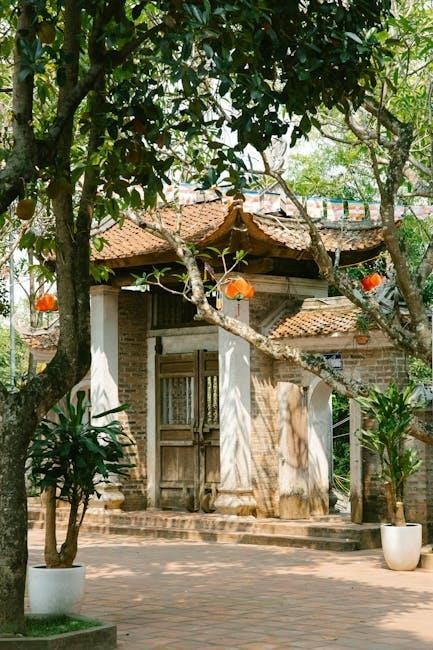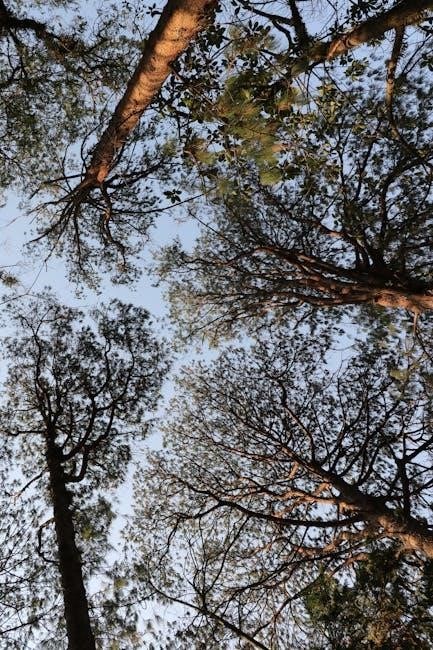The ShelterLogic Max AP Canopy 10×20 is a durable, versatile temporary shelter ideal for outdoor events, vehicle storage, or backyard gatherings. Its sturdy design ensures reliability.
1.1 Overview of the ShelterLogic Max AP Canopy
The ShelterLogic Max AP Canopy 10×20 is a popular, versatile shelter designed for seasonal use. It features an 8-leg steel frame, durable UV-treated polyethylene cover, and a 3-in-1 design for easy customization. Ideal for outdoor events, vehicle storage, or backyard gatherings, it offers reliable protection from the elements. The canopy is lightweight yet sturdy, making it easy to assemble and disassemble as needed. Its compact size and portability ensure flexibility for various applications.
1.2 Importance of Proper Assembly and Anchoring
Proper assembly and anchoring are crucial for the stability and safety of the Max AP Canopy. Improper installation can lead to structural damage or collapse, especially in harsh weather conditions. The canopy is designed as a temporary shelter and must be securely anchored to withstand wind and snow loads. Always follow instructions carefully to ensure a safe and durable setup.
Tools and Parts Needed for Assembly
The Max AP Canopy 10×20 requires basic tools like a wrench and screwdriver for assembly. Ensure all hardware, bungee cords, and frame components are included.
2.1 List of Recommended Tools
For assembling the Max AP Canopy 10×20, you’ll need a wrench, screwdriver, and measuring tape. Optional tools include a ladder and rope for securing. Ensure all parts are included before starting.
2.2 Key Components of the Canopy Kit
The Max AP Canopy 10×20 kit includes a sturdy 8-leg frame, cross rails, 4-way frame connectors, and a durable canopy cover. Additional components are bungee cords (10066), leg pole assemblies, and an anchoring kit. Ensure all parts, including hardware and instructions, are accounted for before assembly begins. Proper organization of these components is essential for a smooth setup process.

Step-by-Step Assembly Instructions
Assemble the frame, place the cover with grommets down, align with cross rails, and secure tightly with bungee cords for a proper setup.
3.1 Assembling the Frame
Begin by unpacking all parts and identifying components. Attach the legs to the frame using the provided connectors. Ensure the frame is square by aligning the corners properly. Use the 4-way connectors to secure the sides and cross rails. Tighten all bolts and screws firmly with a wrench. Double-check the frame’s stability before proceeding to the next step.
3.2 Attaching the Canopy Cover
Place the canopy cover over the assembled frame, ensuring grommet panels face down and align with the cross rails. Secure the cover using bungee cords, tightening them evenly to avoid sagging. Adjust the cords along the cross poles for a snug fit. Ensure the cover is evenly spread and tightly fastened to the frame for optimal stability and durability.
3.3 Final Adjustments and Tightening
After attaching the canopy cover, check all connections and tighten any loose bolts or bungees. Ensure the frame is stable and the cover is evenly tensioned. Adjust the cross rails to align properly and tighten all hardware securely. Regularly inspect and tighten connections to maintain structural integrity and prevent damage from wind or weather conditions.
Securing the Canopy
Properly anchor the Max AP Canopy using the Accessory Anchoring Kit 10073. Tie ropes around frame corners and ensure all connections are tightly secured for stability.
4.1 Anchoring Methods for Different Surfaces
For different surfaces, use specific anchoring techniques. On grass or dirt, drive anchors deeply into the ground. For concrete, use auger anchors. On asphalt, impact anchors work best. Ensure all anchors are tightly secured to prevent shifting. Always check for underground utilities before digging. Proper anchoring ensures stability and safety, especially in windy conditions.
4.2 Using the Accessory Anchoring Kit
The Accessory Anchoring Kit (10073) enhances stability by providing durable tie-down solutions. Attach ropes securely around frame corners using the provided hardware. Ensure tightness to withstand wind and weather. Follow the manual for proper placement and tensioning. Regularly inspect anchors and ropes for wear. This kit is essential for maintaining structural integrity and safety in various conditions. Always prioritize secure anchoring.

Enclosure Kit Installation
The enclosure kit adds privacy and protection. Attach panels using bungee cords, ensuring a snug fit. Leave canopy cover bungees in place for security.
5.1 Attaching Enclosure Panels
Align enclosure panels with the canopy frame, ensuring grommet holes match cross rails. Secure panels using bungee cords, tightening firmly for a snug fit. Leave canopy cover bungees in place during attachment. Ensure panels are evenly spaced and tightly fastened to prevent gaps. Use caution with bungee cords under tension to avoid injury. Proper alignment ensures stability and weather resistance.
5.2 Managing Bungee Cords for a Secure Fit

Adjust bungee cords along the cross poles to ensure a tight, even fit of both the canopy cover and enclosure panels. Leave cover bungees in place when attaching panels to maintain tension. Tighten cords firmly but avoid over-tightening, which could damage the frame or fabric. Ensure cords are evenly spaced for optimal stability and weather resistance. Handle cords with care, as they are under extreme tension.
Common Mistakes to Avoid
Common mistakes include improper anchoring, insufficient tightening of bolts, and failing to secure bungee cords properly. These oversights can lead to structural instability and safety hazards.
6.1 Improper Anchoring Techniques
Improper anchoring is a leading cause of canopy instability. Common mistakes include using insufficient anchors, placing them too far apart, or not securing them tightly to the ground. Always use the recommended anchoring kit and ensure the ground is firm and level. Failure to anchor correctly can lead to the canopy shifting, sagging, or even collapsing during windy conditions. Proper anchoring ensures safety and longevity.
6.2 Overlooking Tightening Procedures
Overlooking tightening procedures can compromise the canopy’s stability and safety. Ensure all bolts, screws, and bungees are securely tightened after assembly. Loose connections can lead to structural weakness, especially in windy conditions. Regularly inspect and tighten hardware to prevent parts from coming loose over time. Neglecting this step can result in sagging, unevenness, or even damage to the frame and cover.
Maintenance Tips
Regularly clean and inspect the canopy for dirt, debris, and wear. Remove any accumulation to ensure proper water runoff and prevent damage. Check all hardware for tightness and address any signs of wear promptly to maintain structural integrity and extend the canopy’s lifespan.
7.1 Regular Cleaning and Inspection
Regularly clean the canopy cover using mild soap and water to remove dirt and debris. Inspect the fabric for tears, and check all hardware for tightness. Address any wear or damage promptly to ensure the canopy remains secure and functional. This maintenance helps prevent water pooling and extends the lifespan of your Max AP Canopy. Cleaning and inspecting regularly ensures optimal performance and safety. It also maintains the structural integrity of the shelter, ensuring it withstands various weather conditions effectively. By following these steps, you can enjoy your canopy for many seasons to come. Regular maintenance is key to preserving your investment and ensuring reliability.
7.2 Dealing with Snow and Debris
Regularly remove snow and debris from the canopy cover to prevent damage and sagging. Use a soft-bristle brush or broom to sweep off snow gently. Avoid using sharp tools, as they may tear the fabric. Ensure the canopy is tightly secured to withstand snow loads. After storms, inspect for damage and tighten any loose connections. Regular checks help maintain structural integrity and ensure safety. Proper upkeep prevents potential hazards and extends the canopy’s lifespan, making it a reliable shelter for various conditions.

Troubleshooting Common Issues
Address sagging covers by tightening frame connections. Inspect for damaged parts and replace them promptly. Regularly check bungee cords for wear and adjust as needed.
8.1 Addressing Sagging or Loose Covers
Sagging or loose covers can be resolved by tightening the bungee cords and ensuring proper alignment with the frame. Re-adjust the bungee positions along the cross poles for a snug fit. Regularly inspect and clean the cover to prevent debris buildup. If sagging persists, check for worn-out parts and replace them. Proper anchoring and maintaining even tension are crucial for stability.
8.2 Fixing Damaged or Worn-Out Parts
Inspect the canopy for damaged or worn-out components like torn covers, loose joints, or broken connectors. Replace any damaged parts with compatible replacements. Tighten all connections and ensure bungee cords are secure. Regular maintenance, such as cleaning and inspecting, can prevent further damage. Addressing issues promptly ensures the canopy remains stable and functional. Always refer to the manual for specific replacement guidelines.

Seasonal Considerations
Adapt your canopy setup for varying weather conditions. Reinforce anchoring in windy or snowy seasons. Regularly clean debris and inspect for wear. Store disassembled during harsh winters to prolong longevity and ensure optimal performance year-round.
9.1 Setting Up for Different Weather Conditions
Adapt your Max AP Canopy setup to suit varying weather. For windy conditions, ensure secure anchoring with ropes and stakes. In snowy weather, maintain a tight cover and clear debris to prevent sagging. Regularly inspect and tighten connections. Use the accessory anchoring kit for added stability. Always clean debris and avoid installing near structures that shed snow or water. Proper preparation ensures durability and safety in all seasons.
9.2 Storage and Disassembly Best Practices
For proper storage, disassemble the canopy frame and clean all parts thoroughly. Store components in a dry, protected area to prevent damage. Use labeled bags for hardware to ensure easy reassembly. Check for worn-out parts and replace them before storing. Cover the canopy cover to shield it from dust and moisture. Regular maintenance ensures longevity and readiness for future use.

Safety Warnings and Precautions
The Max AP Canopy is a temporary structure, requiring secure anchoring to prevent collapse. Avoid areas near trees, power lines, or where snow or ice could cause damage. Never use near open flames or flammable materials. Ensure all parts are tightly secured before use.
10.1 General Safety Guidelines
Always wear safety gear, including gloves and eyewear, during assembly and disassembly. Ensure the area is clear of obstructions and overhead hazards. Follow all instructions carefully to avoid accidents.Inspect the canopy for damage before each use and ensure all parts are securely tightened. Never use the canopy in extreme weather conditions without proper anchoring. Keep children and pets away during assembly.
10.2 Avoiding Hazardous Installation Locations
Avoid installing the canopy near overhead obstructions, such as trees or power lines, to prevent damage from falling debris or electrical hazards. Do not set up on uneven ground, as it may destabilize the structure. Keep the canopy away from low-hanging power lines and areas prone to water pooling. Additionally, avoid locations near structures that shed snow or ice onto the canopy.
Your Max AP Canopy 10×20 is now ready for use! Ensure all steps are followed for safety and durability. Contact customer support for any assistance needed.
11.1 Final Checks Before Use
Before using your Max AP Canopy 10×20, ensure all connections are secure and tightened properly. Verify the frame is straight, the cover is tightly fitted, and all bungees are in place. Check anchors for stability and ensure no loose parts remain. Confirm all safety guidelines are met and the area is clear of obstacles for safe use.
11.2 Contacting Customer Support for Assistance
If you encounter issues or have questions during assembly or use, contact ShelterLogic customer support at 1-800-524-9970. Provide your model number and a detailed description of the issue for prompt assistance. Refer to the warranty card for additional support options and ensure all installation guidelines were followed correctly for optimal performance and safety.
